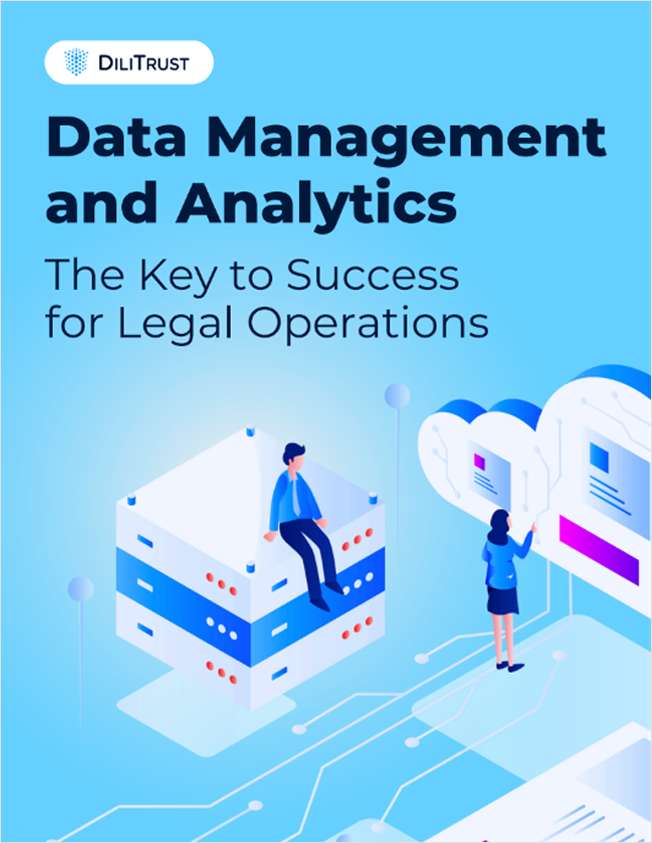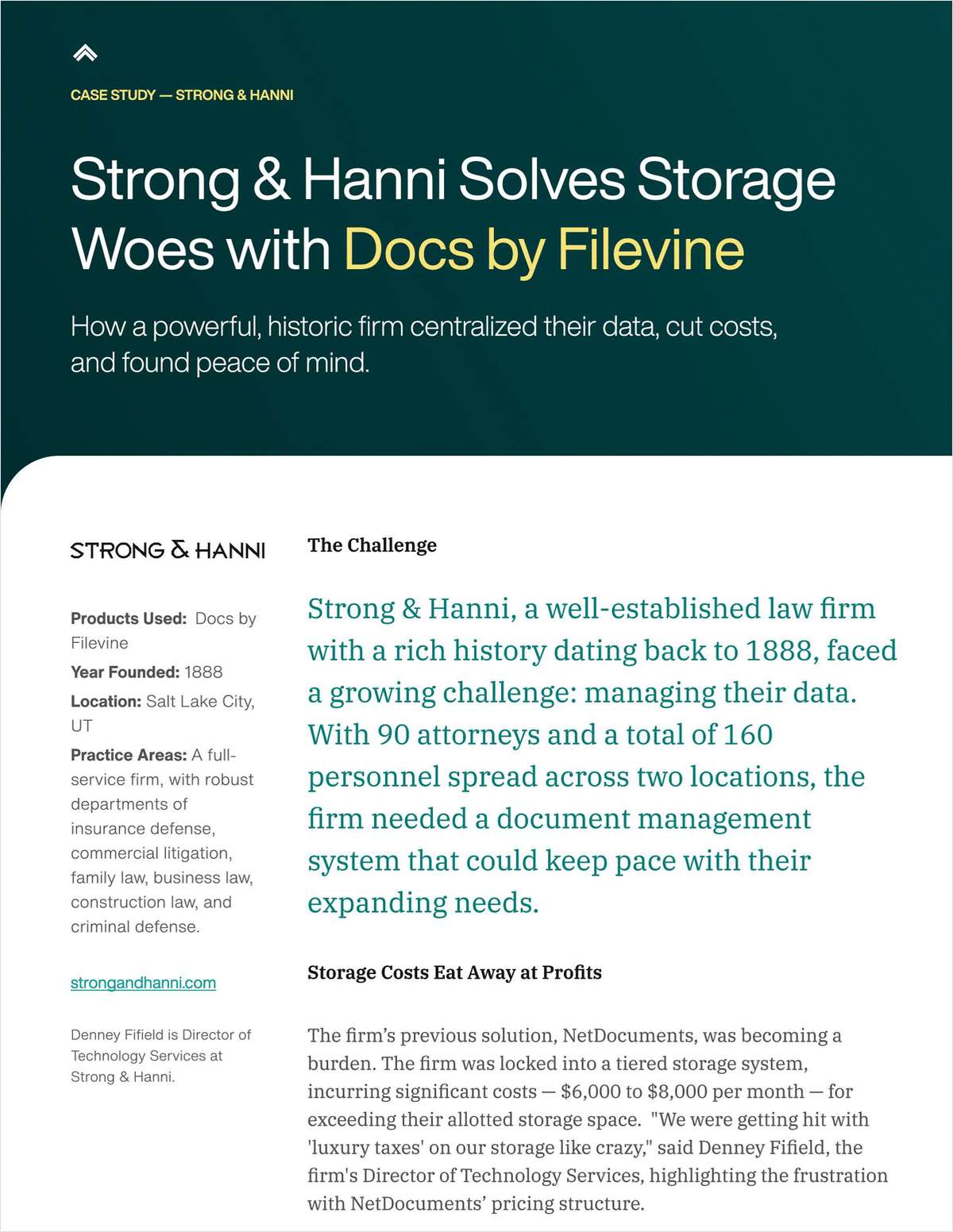Corporate Law On Verge of Making Things Simpler with Complex Analytics
HBR Consulting released a survey last week showing that the use of analytics within corporate law departments is on the rise, with many looking to venture deeper with the technology than they ever have before.
May 24, 2019 at 08:00 AM
3 minute read
The original version of this story was published on Legal Tech News

Corporate law departments are not only starting to deploy legal analytics with more frequency, they're also leveraging the technology against increasingly complex tasks, according to a new survey by HBR Consulting.
Launched during last week's Corporate Legal Operations Consortium (CLOC) institute in Las Vegas, the survey was conducted over a period stretching from December 2018 to January 2019 and incorporates responses from senior legal professionals working in corporate law departments spread across 32 U.S. companies. One key takeaway? Analytics are advancing up the corporate agenda.
“Not only is [analytics] on the radars, but it's moved up to the point where it's a high priority or kind of in the top set of priorities. … It's something that we think is pretty compelling,” said Andrew Baker, senior director at HBR Consulting.
Compelling and statistically accurate, at least according to HBR's survey. The large portion of respondents, 41 percent, categorized data science and analytics as a “medium priority,” while 38 percent identified as being in the early planning stages. As for the two extremes, 16 percent of respondents called data science and analytics as a “high priority,” while only 6 percent said it was “not a priority.”
Baker posited several theories as to why analytics may be bounding up the ladder, ranging from the sophistication of the tools now available to the general wealth of data resting at a company's fingertips. Still, while more companies may be engaging with analytics, they're not all doing it at the same level or even with the same goal in mind. Baker alluded to a general progression in ambition that emerges as law departments start to become more comfortable with data and analytics.
“We think it's natural for those that kind of get in, orient themselves, find the right use cases and build up some of that muscle memory to continue to advance and go after bigger things,” Baker said.
Case in point, HBR's survey breaks respondents down into two types of user groups. The “Data Experienced” crowd, which use analytics for diagnostic, predictive, or prescriptive purposes, made up 47 percent of the survey, while the “Data Exploring” category, which focused on foundational or descriptive analytics, accounted for the remaining 53 percent of respondents.
As one might expect, Data Experienced respondents appear more likely to apply analytics towards future high-complexity projects. For example, 40 percent of these respondents indicated that in the near future, they would use analytics when reviewing contracts or related risk, as opposed to only 35 percent of the Data Exploring group.
Still, the use of high-complexity analytics tools that can do things like predict dispute outcomes or evaluate outside counsel's substantive performance looks to be on the verge of increasing across the board. While 41 percent of all survey respondents indicated that they were currently using high-complexity analytics, 63 percent indicated that they would be doing so in the future.
It's not like the incentive isn't there. Baker thinks the opportunity to deploy complex analytics exists within most companies. Even businesses with no immediate need or budget for complex data tools could have one or two areas of risk that warrant some kind of investment.
“Whatever that might be for you: labor deployment, product liability, IP. Whatever your hot spot is or the thing that's a byproduct of what you do as a company, that might be an area where you kind of double down and try to go deeper into analytics,” Baker said.
This content has been archived. It is available through our partners, LexisNexis® and Bloomberg Law.
To view this content, please continue to their sites.
Not a Lexis Subscriber?
Subscribe Now
Not a Bloomberg Law Subscriber?
Subscribe Now
NOT FOR REPRINT
© 2024 ALM Global, LLC, All Rights Reserved. Request academic re-use from www.copyright.com. All other uses, submit a request to [email protected]. For more information visit Asset & Logo Licensing.
You Might Like
View All

As Tech-Focused Roles in C-Suite Expand, Newcomers Embrace Big Law Opportunities

What About the Old Partners Who Have No Interest in AI?

Avantia CEO Discuss Blurring Lines Between Law Firm, Software Provider and ALSP
8 minute readTrending Stories
- 1Infant Formula Judge Sanctions Kirkland's Jim Hurst: 'Overtly Crossed the Lines'
- 2Trump's Return to the White House: The Legal Industry Reacts
- 3Election 2024: Nationwide Judicial Races and Ballot Measures to Watch
- 4Climate Disputes, International Arbitration, and State Court Limitations for Global Issues
- 5Judicial Face-Off: Navigating the Ethical and Efficient Use of AI in Legal Practice [CLE Pending]
- 6How Much Does the Frequency of Retirement Withdrawals Matter?
Who Got The Work
Michael G. Bongiorno, Andrew Scott Dulberg and Elizabeth E. Driscoll from Wilmer Cutler Pickering Hale and Dorr have stepped in to represent Symbotic Inc., an A.I.-enabled technology platform that focuses on increasing supply chain efficiency, and other defendants in a pending shareholder derivative lawsuit. The case, filed Oct. 2 in Massachusetts District Court by the Brown Law Firm on behalf of Stephen Austen, accuses certain officers and directors of misleading investors in regard to Symbotic's potential for margin growth by failing to disclose that the company was not equipped to timely deploy its systems or manage expenses through project delays. The case, assigned to U.S. District Judge Nathaniel M. Gorton, is 1:24-cv-12522, Austen v. Cohen et al.
Who Got The Work
Edmund Polubinski and Marie Killmond of Davis Polk & Wardwell have entered appearances for data platform software development company MongoDB and other defendants in a pending shareholder derivative lawsuit. The action, filed Oct. 7 in New York Southern District Court by the Brown Law Firm, accuses the company's directors and/or officers of falsely expressing confidence in the company’s restructuring of its sales incentive plan and downplaying the severity of decreases in its upfront commitments. The case is 1:24-cv-07594, Roy v. Ittycheria et al.
Who Got The Work
Amy O. Bruchs and Kurt F. Ellison of Michael Best & Friedrich have entered appearances for Epic Systems Corp. in a pending employment discrimination lawsuit. The suit was filed Sept. 7 in Wisconsin Western District Court by Levine Eisberner LLC and Siri & Glimstad on behalf of a project manager who claims that he was wrongfully terminated after applying for a religious exemption to the defendant's COVID-19 vaccine mandate. The case, assigned to U.S. Magistrate Judge Anita Marie Boor, is 3:24-cv-00630, Secker, Nathan v. Epic Systems Corporation.
Who Got The Work
David X. Sullivan, Thomas J. Finn and Gregory A. Hall from McCarter & English have entered appearances for Sunrun Installation Services in a pending civil rights lawsuit. The complaint was filed Sept. 4 in Connecticut District Court by attorney Robert M. Berke on behalf of former employee George Edward Steins, who was arrested and charged with employing an unregistered home improvement salesperson. The complaint alleges that had Sunrun informed the Connecticut Department of Consumer Protection that the plaintiff's employment had ended in 2017 and that he no longer held Sunrun's home improvement contractor license, he would not have been hit with charges, which were dismissed in May 2024. The case, assigned to U.S. District Judge Jeffrey A. Meyer, is 3:24-cv-01423, Steins v. Sunrun, Inc. et al.
Who Got The Work
Greenberg Traurig shareholder Joshua L. Raskin has entered an appearance for boohoo.com UK Ltd. in a pending patent infringement lawsuit. The suit, filed Sept. 3 in Texas Eastern District Court by Rozier Hardt McDonough on behalf of Alto Dynamics, asserts five patents related to an online shopping platform. The case, assigned to U.S. District Judge Rodney Gilstrap, is 2:24-cv-00719, Alto Dynamics, LLC v. boohoo.com UK Limited.
Featured Firms
Law Offices of Gary Martin Hays & Associates, P.C.
(470) 294-1674
Law Offices of Mark E. Salomone
(857) 444-6468
Smith & Hassler
(713) 739-1250








